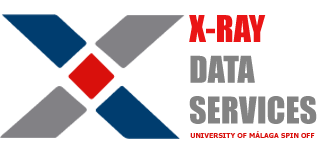BENEFITS OF THE MINING SECTOR

Identification of mineral components.

Characterization of raw materials: optimize dosing. Cost savings in raw materials.

Optimize operating process conditions. Higher quality product.

Online mineralogical analysis: optimization of material recovery. Economic savings.

Monitor the content of precious metals in furnace slags.
KNOW IN DETAIL WHAT BENEFITS WE CAN BRING TO THE MINING SECTOR
Identification of mineral components.
By drx analysis of powder samples it is possible to identify and quantify mineral components such as mixed crystalline phases (polycrystallines) and amorphous phases. It also provides us with information on the structural status of the same.
It is also feasible to apply this technique for the characterization/analysis of clay minerals (such as smectites) and laminars (such as micas, chlorites, etc.) by developing a procedure defined in the stages of granulometric separation, preferential orientation, saturation with ethylene glycol vapours and/or heat treatment; in order to evaluate structural changes that are characteristic for certain clays. Quantitative analysis of mixtures containing X-ray diffraction clays and Rietveld method is possible but needs significant crystalchemical know-how.
Characterization of raw materials: optimize dosing. Cost savings in raw materials.
Another application of diffraction is the research of raw materials, through the study of phase changes that can be made by tracking structural changes of the crystalline phases contained in a sample. These changes can occur under different conditions of temperature, pressure, grinding, among others.
Although this technique can be recognized as conventional, its application is fundamental to the mineralogical characterization of a deposit; as well as to define the different minerals/phases that predominate within a metallurgical process.
Optimize conditions. Higher quality product
X-ray diffraction can assist in quality control by mapping mineral deposit composition and drilling witnesses. Using Cluster Analysis it is possible to quickly group diffractograms without much prior knowledge of the sample to carry out statistical studies.
For example, it is possible to distinguish between iron ores and waste materials from hot steel laminate. These minerals are very similar, but with DRX they can be easily distinguished and even quantified using Rietveld’s methodology.
Optimization of material recovery. Economic savings
Special diffractometers with a given optics are used for in-line mineralogical analysis. The information obtained from the qualitative and quantitative in-line analysis of the mineral phases present in copper pulps provides a powerful tool for the control of the flotation process and for the monitoring of bargain material such as clays, feldspars, etc.
With this information it is possible to optimize its recovery, reduce the consumption of additives and therefore improve the quality of the concentrate. This improves copper and molybdenum recovery for example.
Monitor the content of precious metals in furnace slags.
Combined the techniques of FRX and DRX it is possible to carry out the analysis of main elements and trace in geological samples (pearls) (FRX), and characterize the two main rare earth oxides, which are bastnasite and monasticite (DRX).
